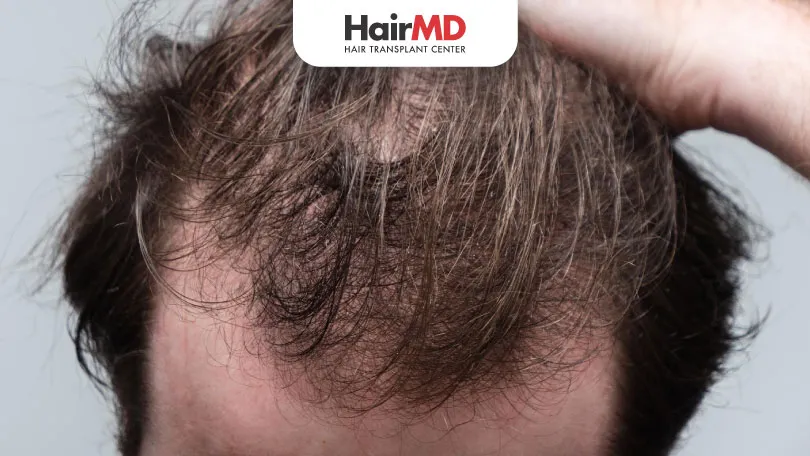
What’s covered in the article?
- What is telogen effluvium hair loss?
- What are the causes of telogen effluvium?
- Conclusion
What is telogen effluvium hair loss?
Telogen effluvium is the second most common type of hair loss. It happens when more hair than usual enters the resting (telogen) phase of the hair growth cycle and then falls out. This often occurs after a stressful event, like an illness or emotional shock.
Basically, something “shocks” your system, causing hair that was growing to suddenly stop and enter a resting phase. About 2 to 4 months later, this resting hair starts to fall out. The good news is that this type of hair loss is usually temporary. Once the stressor is gone, new hair typically grows back. In fact, a lot of hair falling out can actually be a sign of new hair pushing out the old, dead hair. You might even notice a fine line of new hair along your forehead.
Initially, a lot of hair falls out, and your hair might look thinner. But after a few months, this usually slows down, and your hair gradually returns to normal over 6-9 months. However, if the cause isn’t fixed, recovery might not be complete.
Anyone can get telogen effluvium, but it’s more common in women, especially after childbirth, due to hormonal changes. Women also tend to be more concerned about hair shedding and seek medical help more often.
What are the causes of telogen effluvium?
In a normal healthy person’s scalp, about 85% of the hair follicles actively grow hair (anagen hair) and about 15% rest (telogen hair). It is normal to lose up to about 100 hairs a day on one’s comb, brush, basin, or on the pillow due to the normal scalp hair cycle. However, if there is some shock to the system, as many as 70% of the anagen hairs can be precipitated into telogen, thus reversing the usual ratio.
Typical triggers of telogen effluvium hair loss include:
- Just had a baby? Postpartum hair loss is a common trigger.
- Been sick? Acute or chronic illness, especially with a high fever, can be a culprit.
- Surgery or accident? These stressful events can sometimes lead to hair shedding.
- Feeling stressed out? Psychological stress can play a role.
- Diet changes? Significant weight loss, an unhealthy diet, or nutrient deficiencies (like iron or potassium) can trigger it.
- Medication matters. Certain medicines can be a cause.
- Hormone havoc? Conditions like hypothyroidism or hyperthyroidism can be triggers.
- Off the pill? Stopping contraceptive pills can sometimes lead to hair loss.
- Too much sun? Excessive sun exposure can also be a factor.
Telogen effluvium hair loss isn’t permanent. Although your hair will likely take the shape of its usual growth pattern within six months, it may take from one year to 18 months before your hair returns to its original appearance. During this time, it is always a good idea to support your hair with proper hair care and nutrition.
Do You Know?
Nearly 250 Patients Visit HairMD
Everyday For Various Hair Concerns?
(Your journey to healthier and fuller hair starts here!)
Meet Our Dermatologists
Conclusion
Further Reading
Hair Transplant vs Hair Wigs – Pune Specialists Explain
Pune specialists compare hair transplants vs wigs. Learn costs, maintenance & why transplants are better long-term investment. Expert guide from HairMD India.
PRP Therapy for Hair Loss in Pune 2026 – Cost, Effectiveness & Results
Complete guide to PRP therapy for hair loss in Pune 2026. Learn about costs (₹3,000-15,000/session), 70-80% success rates, procedure details, and how it compares to FUE and medications.
Ethical Hair Transplant Practices – Why HairMD Pune Is Trusted?
Discover what ethical hair transplant practices look like and why patients trust HairMD Pune. Learn to spot red flags, verify surgeon credentials, and make informed decisions for your hair restoration journey
Low-Cost Hair Transplant Clinics in Pune – Risks & Warnings
Discover why ultra-low-cost hair transplants in Pune are dangerous. Learn red flags, true costs, and how to verify surgeon credentials before risking your scalp health.
Have thoughts? Please let us know
We are committed not only to treating you, but also educating you.











